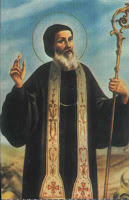 Yesterday, November 1st,
we observed the All Saint’ day, the feast of those holy men and women who are
in the Church’s roll of saints and who are not.
Today, on November 2nd we turn our attention to those souls
who are in the Church Suffering or the purgatory. Today, we pray for the purification of the
souls in Purgatory, remembering those who have gone before us, and entreating
the Lord to take them into Heaven. Welcome to the saint of the day.
Yesterday, November 1st,
we observed the All Saint’ day, the feast of those holy men and women who are
in the Church’s roll of saints and who are not.
Today, on November 2nd we turn our attention to those souls
who are in the Church Suffering or the purgatory. Today, we pray for the purification of the
souls in Purgatory, remembering those who have gone before us, and entreating
the Lord to take them into Heaven. Welcome to the saint of the day.
"All who die in God's grace and friendship, but still
imperfectly purified, are indeed assured of their eternal salvation; but after
death they undergo purification so as to achieve the holiness necessary to
enter heaven.
The Church gives the name Purgatory to this final
purification of the elect, which is entirely different from the punishment of
the damned. The Church formulated her doctrine of faith on Purgatory especially
at the Councils of Florence and Trent.”
There is no dogma of the Church which speaks about the
duration of the punishment and purification and the exact nature of the cleansing. Many saints, including St. Augustine refer to
Purgatory through the imagery of fire. In our times Pope Benedict XVI has come
out with an explanation of Purgatory as a state of existence, different from
the states in the temporal plane, an experience out side space and time.
According to him it is time of preparation for entry into heaven, a place which
is pure beyond anything that we have experienced here on earth. To enter into
that realm of pure presence of Almighty God some cleansing is required in the
case of many souls.
Saints are souls who have been given heaven, the rewards of
Heaven, at the very moment of their death.
These saints can intercede for us. However, there are many who lived
Christian life and died in friendship with God, yet not cleansed from their
sins completely which makes them unfit for beatific vision of God. Their past
transgressions have not been completely blotted out. The Church calls the place where they are
preparing to enter heaven, purgatory.
The faithful who are on earth can help those dear departed through
prayers, alms, deeds and especially by the sacrifice of the Mass.
Apart from the spiritual benefits of observing the All Souls
Day, it gives an opportunity for us to remember the dear departed. It helps us
to think of the way they led Christian life. Remembering, them, saying Mass for
them and giving alms are also opportunity to pay homage to them.
















